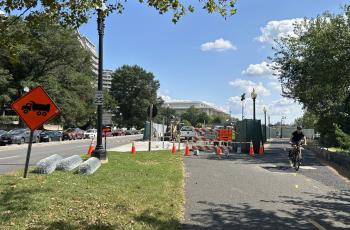1. What is a Clean Rivers Impervious Area Charge (CRIAC)?
An impervious surface is a man-made surface that cannot be easily penetrated by water, such as rooftops, driveways, patios, tennis courts, swimming pools, parking lots, and other paved or covered areas (regardless of materials used).
Impervious surface areas are a major contributor to rainwater runoff entering the District's sewer system and pollution entering area waterways. The CRIAC is based upon the amount of impervious surface on your property.
2. Why is the CRIAC necessary?
The charge is necessary to recover the costs of the $3.27 billion federally mandated Clean Rivers Project (linked). The plan will reduce the discharge of excess combined sewer overflows into local waterways from DC Water's combined sewer system.
3. Why did DC Water decide to defray the costs of the Clean Rivers Project in this manner?
The DC Water Board of Directors determined that the CRIAC is a more equitable way to recover the costs of the Clean Rivers Project than the volumetric charge (for water used), because the CRIAC is based on a property's contribution to rainwater runoff.
4. How is the amount of the charge determined?
The charge is based on an Equivalent Residential Unit (ERU). An ERU is a measure of the amount of impervious surface area in a single-family residential property in square feet. All nonresidential customers are assessed ERUs based on the total amount of impervious surface on each lot. The approved monthly ERU values for FY 2025 and FY 2026 are $21.23 and $24.23 respectively.
Residential Customers: Beginning in FY 2011, all residential customers were assessed ERUs based upon the amount of impervious surface on their property and the following six-tier rate structure:
| Current FY 2024 (Effective 10/1/2021) |
Proposed FY 2025 (Effective 10/1/2024) |
Proposed FY 2026 (Effective 10/1/2025) |
|||||
| Area (Square Feet) | ERU | ERU Rate | Monthly Cost | ERU Rate | Monthly Cost | ERU Rate | Monthly Cost |
| 100-699 | 0.6 | $21.86 | $13.12 | $21.23 | $12.74 | $24.23 | $14.54 |
| 700-2,099 | 1.0 | $21.86 | $21.86 | $21.23 | $21.23 | $24.23 | $21.86 |
| 2,100-3,099 | 2.4 | $21.86 | $52.46 | $21.23 | $50.95 | $24.23 | $58.15 |
| 3,100-7,099 | 3.8 | $21.86 | $83.07 | $21.23 | $80.67 | $24.23 | $92.07 |
| 7,100-11,099 | 8.6 | $21.86 | $88.00 | $21.23 | $182.58 | $24.23 | $208.38 |
| 11,100 and more | 13.5 | $21.86 | $295.11 | $21.23 | $286.61 | $24.23 | $327.11 |
All nonresidential customers are assessed ERUs based on the total amount of impervious surface on each lot.
5. Why did DC Water develop a Tiered Rate structure for residential customers?
The tiers were developed in order to bill residential customers more equitably, based on the size of their properties.
6. If I do not agree with the square footage for which DC Water is billing me, how can I appeal?
You may follow the bill dispute process (link) located on the back of your bill.
7. How was the square footage determined for my property?
Square footage is measured using the geographical information system data from DC GIS and Office of the Surveyor.
8. Is there a discount for residents who implement measures to manage and/or reduce wet weather runoff?
To apply for the IAC Incentive Program, and receive more information on the District Department of Energy & Environment's Riversmart Rewards Program, visit their website here.


